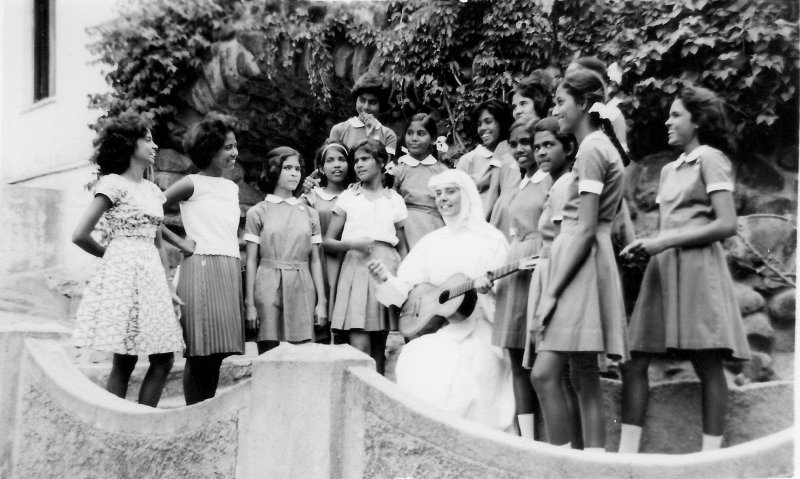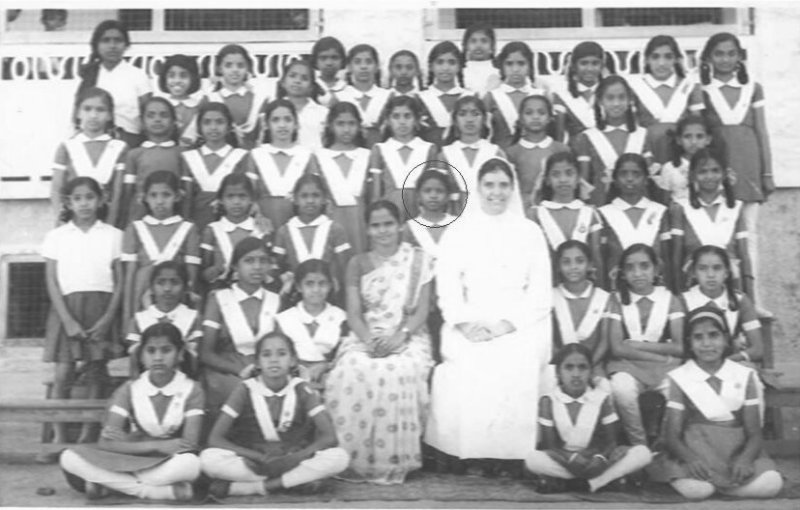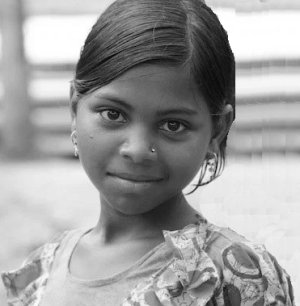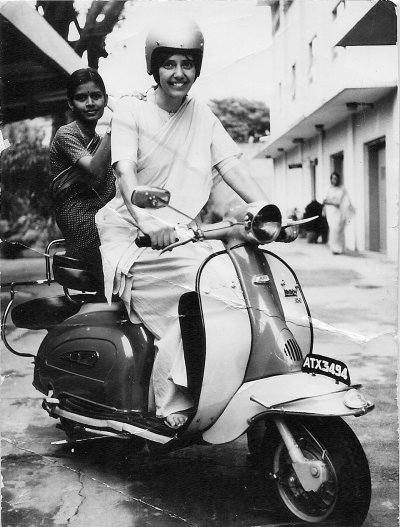Mission in India
Jackie’s new life as a Catholic took a dramatic new turn when she decided to become a missionary. Reading about the plight of so many deprived people in the Third World she felt she could not just stand by and do nothing, So in September 1962 she became a member of the Franciscan Missionaries of Mary. This is a religious congregation concerned with educational, social and medical welfare and development in all parts of the world.
She was appointed to India. From 1965 to 1969 she served as Assistant Headmistress of Rosary Convent High School, Hyderabad, Andhra Pradesh. It was a combined primary and secondary school with 4500 girls from 4 years to 17 years old. Jackie taught art, crafts, religious knowledge and moral science.

Jackie playing the guitar for children of Rosary Convent School
In 1969 her teaching post was interrupted to allow her to be further qualified. In line with the injunctions of the Second Vatican Council religious sisters in India were offered new intensive theology courses. Jackie studied theology and scripture at Sudeep Training Institute, Bangalore, India for one year. She remained there the following year as a member of the staff.
In 1971 Jackie was appointed Headmistress of Fatima Girls’ High School, Kazipet, Andhra Pradesh. This was a combined primary and secondary school with 850 pupils, having boys as well as girls in the primary section. The age range of the school was from 3 years to 16 years with about 100 pupils remaining as boarders throughout the school year. Jackie taught art and crafts in the senior school, and began an art club for a wider age range. She also taught religious knowledge for the Christians, and moral science for the Hindus and Muslims. She acted as area animator for the Y.C.S. movement ( Young Christian Students) which involved organising regular meetings for the youth of schools and colleges; summer camps for the different groups; various workshops during the year.

Jackie with a class of students in Kazipet Highschool
Jackie became Principal of Immaculata Industrial School, Hanamkonda, Warangal District, Andhra Pradesh in 1974. This project involved 75 girls aged between 9 years and 18 who stayed as resident pupils throughout the school year. The programme had been designed especially for economically backward and deprived girls from rural areas in Andhra Pradesh. lt aimed at providing the girls with social, moral and educational formation, combined with an appreciation of their own cultural heritage of music, dance and drama. Jackie’s work in Hanamkonda extended to 6 outlying villages within a radius of 50 miles. For them she acted as the coordinator of community development projects for adult education and training schemes. Also, she was elected to serve a term of 3 years as a councillor on the Provincial Council of my congregation. That Council determined matters concerning the smooth functioning of 30 different educational, social and medical institutions managed by the sisters in the three States: Andhra, Kerala and Karnataka.
Sabitha
Later Jackie wrote an article for The Catholic Herald (16 October 1983) in which she described the story of a typical case of neglect and promise she came across during her missionary work in India.
“SABITHA stood alone gazing silently at the other children laughing and playing – a forlorn figure clutching her tin case tightly with both hands. Poor little thing, I thought. This was India in 1977. I was among a group of nine Franciscan sisters running a basic education and training centre for village girls in Hanamkonda, Andhra Pradesh. Friends had asked us if we’d care for Sabitha, about nine years old, for a few months until they could find a place for her in a home for the deaf.
There was little else we really knew about her, as Sabitha’s own history began and ended with the present – she couldn’t speak to tell us about her life. All we knew of the past was that about four years earlier some coolies had picked her up unconscious and badly injured from beside the railway line. They had taken her to the nearest hospital where she was placed on a mattress in the crowded ward, where at least she could be cared for until she died.
She did not die, but when she came out of the coma she had only a fraction of hearing and no speech at all. No one knew where she came from. No one came to claim her. So for four years she lived in the hospital like a stray creature, being looked after by some of the nurses who had the love and time to bother – begging her food from patients and visitors, and wheedling a rupee now and again from some kind hearted doctors in order to buy sweets from the dubious stalls at the roadside by the hospital.

Our Christian friends saw her there, and concerned about her future, obtained permission to make her their ward. We gladly agreed to look after her for a while, but now that she was here I wondered how she would fit in – a handicapped child living with the rather boisterous crowd of girls we had would surely find it hard to keep her place. Poor little thing.
Poor little thing? I was soon to learn that it wasn’t Sabitha who was poor. The immense riches of her character and personality flowed out to all of us as we came to know and trust each other. It was mainly the question of finding the right wavelength for communication. What we lacked in sound we made up for in a variety of signs, until we had our own brand of language which covered day to day events, and on which we built for any new occasion.
Not only did she fit in with the other girls, sharing their life as far as she could out of class hours, but played their games and laughed with them. Yes laughed, as laughter was the only sound she could make. During lessons she would find anyone of us sisters free from class and try to involve herself in whatever we were up to: cooking, sewing or writing. She somehow charmed her way into our daily routine – yes charmed so that we never realised just how demanding she really was.
Enthusiastic about learning anything new she’d go on and on at it for days. When the new thing was my typewriter, my list of urgent and outstanding correspondence grew considerably! Sabitha had to write to everyone, giving each of us a message full of marvellously jumbled up letters . . . and it didn’t end there. We had to read back to her in signs what we thought she’d written to us. Plenty of practice for the imagination!
Her own imagination knew no bounds, as her evening entertainment was to mime events of the day and mimic characteristics of everyone she’d been with. It was all so realistic and at times so amusing, the whole drama of it kept us enthralled and often in fits of laughter!
Yet there were the dark times, when she would curl up, withdrawn, and it seemed as if we did not exist for her. Maybe it had something to do with an event she often acted out – murder on a train. Would that have been about her family? Who knows … It was only possible then to stay quietly holding on to her and wait, until after a long sigh she would start up our sign language again, and her smile to me would break through the unknown pain.
Disabled? What is her contribution to society? These are questions which may come to mind too readily, and a computer would be hard put to it to come up with economically satisfactory answers. All I know is that the part of her life Sabitha spent with us has enriched my own life. It was a time of gift. A gift of glimpsing for a moment, in this rushing around world, a different coloured dimension of human existence. One which doesn’t need to depend upon happy ever after endings, but one which lives in the possibility of a present with purpose -:- an important NOW.
Is the ideal image of a perfect life to be just like the ads on the telly? Or to be frozen beautifully forever behind glass in shop windows? The pity is not that Sabitha cannot speak, or that she cannot hear. The pity is. that people who have been made with the capacity to love and share do not bother to love or share. When St Francis embraced the leper – a person most to be pitied and hidden away in his day – he valued as his own the so-called least of the living. It is as if the freedom to give springs into joy when we reach out with another to grow!”
Final years in India

Jackie on her scooter going to Amruthavani Centre
From 1978 to 1979 Jackie functioned as coordinator of training and formation programmes for Indian religious sisters in her congregation for the three States of Andhra, Kerala and Karnataka. She was also a member of my Provincial Information Team as editor and general factotum of the area newsletter.
She also worked as part time research associate with Fr Gino Henriques cssr, at Amruthavani, the Catholic Communications Centre in Secunderabad. This research project was an overall evaluation covering each department of the multimedia communications centre, in order to determine the value of output and feedback for each section in relation to the medium used, and culture of the milieu.
In 1979 she began a series of intensive communication courses, first at the Crec-Avec Institute of Lyons, France, then at St. Paul’s University of Ottawa in Canada and finally at the Communication Centre of Dublin in Ireland.
Next Housetop
THE STORY OF MY LIFE
- » FOREWORD
- » Part One. LEARNING TO SURVIVE
- » origins
- » into gaping jaws
- » from the pincers of death
- » my father
- » my mother
- » my rules for survival
- » Part Two. SUBMIT TO CLERICAL DOGMA — OR THINK FOR MYSELF?
- » seeking love
- » learning to think
- » what kind of priest?
- » training for battle
- » clash of minds
- » lessons on the way to India
- » Part Three (1). INDIA - building 'church'
- » St John's Seminary Hyderabad
- » Andhra Pradesh
- » Jyotirmai – spreading light
- » Indian Liturgy
- » Sisters' Formation in Jeevan Jyothi
- » Helping the poor
- » Part Three (2). INDIA – creating media
- » Amruthavani
- » Background to the Gospels
- » Storytelling
- » Bible translation
- » Film on Christ: Karunamayudu
- » The illustrated life of Christ
- » Part Three (3). INDIA - redeeming 'body'
- » spotting the octopus
- » the challenge
- » screwed up sex guru
- » finding God in a partner?
- » my code for sex and love
- » Part Four. MILL HILL SOCIETY
- » My job at Mill Hill
- » The future of missionary societies
- » Recruitment and Formation
- » Returned Missionaries
- » Brothers and Associates
- » Part Five. HOUSETOP LONDON
- » Planning my work
- » Teaching teaching
- » Pakistan
- » Biblical Spirituality
- » Searching God in our modern world
- » ARK2 Christian Television
- » Part Five (2) New Religious Movements
- » Sects & Cults
- » Wisdom from the East?
- » Masters of Deception
- » Part Five (3). VIDEO COURSES
- » Faith formation through video
- » Our Spirituality Courses
- » Walking on Water
- » My Galilee My People
- » Together in My Name
- » I Have No Favourites
- » How to Make Sense of God
- » Part Six (1). RESIGNATION
- » Publicity
- » Preamble
- » Reaction in India
- » Mill Hill responses
- » The Vatican
- » Part 6 (2). JACKIE
- » childhood
- » youth and studies
- » finding God
- » Mission in India
- » Housetop apostolate
- » poetry
- » our marriage
